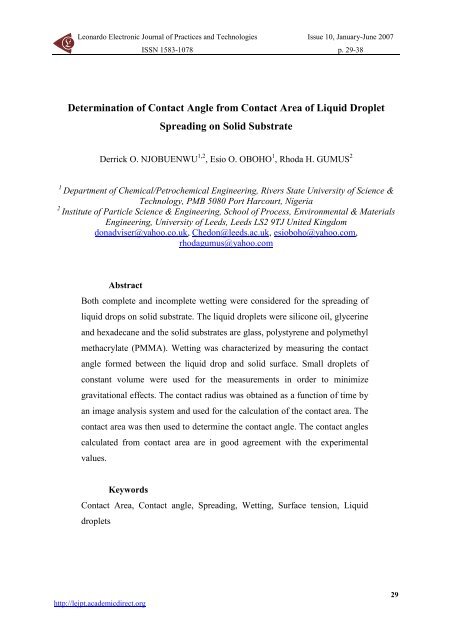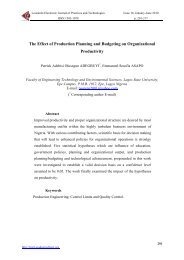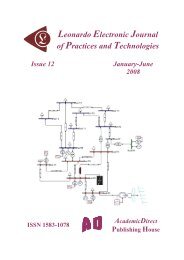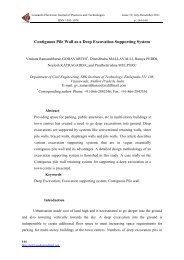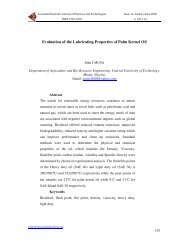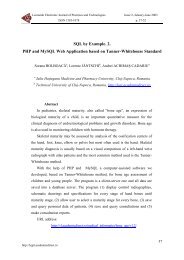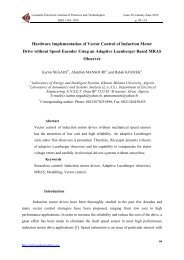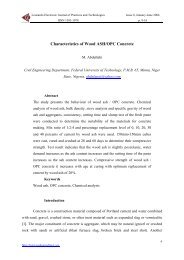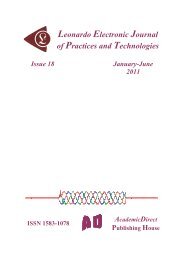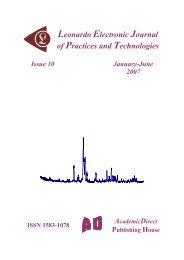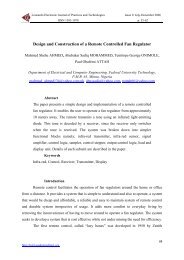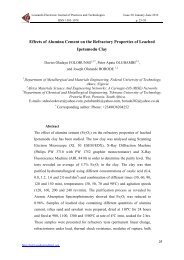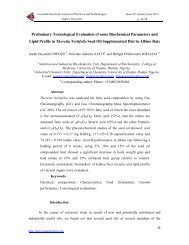Determination of Contact Angle from Contact Area of Liquid Droplet ...
Determination of Contact Angle from Contact Area of Liquid Droplet ...
Determination of Contact Angle from Contact Area of Liquid Droplet ...
Create successful ePaper yourself
Turn your PDF publications into a flip-book with our unique Google optimized e-Paper software.
Leonardo Electronic Journal <strong>of</strong> Practices and Technologies<br />
ISSN 1583-1078<br />
http://lejpt.academicdirect.org<br />
Issue 10, January-June 2007<br />
p. 29-38<br />
<strong>Determination</strong> <strong>of</strong> <strong>Contact</strong> <strong>Angle</strong> <strong>from</strong> <strong>Contact</strong> <strong>Area</strong> <strong>of</strong> <strong>Liquid</strong> <strong>Droplet</strong><br />
Spreading on Solid Substrate<br />
Derrick O. NJOBUENWU 1,2 , Esio O. OBOHO 1 , Rhoda H. GUMUS 2<br />
1 Department <strong>of</strong> Chemical/Petrochemical Engineering, Rivers State University <strong>of</strong> Science &<br />
Technology, PMB 5080 Port Harcourt, Nigeria<br />
2 Institute <strong>of</strong> Particle Science & Engineering, School <strong>of</strong> Process, Environmental & Materials<br />
Engineering, University <strong>of</strong> Leeds, Leeds LS2 9TJ United Kingdom<br />
donadviser@yahoo.co.uk, Chedon@leeds.ac.uk, esioboho@yahoo.com,<br />
rhodagumus@yahoo.com<br />
Abstract<br />
Both complete and incomplete wetting were considered for the spreading <strong>of</strong><br />
liquid drops on solid substrate. The liquid droplets were silicone oil, glycerine<br />
and hexadecane and the solid substrates are glass, polystyrene and polymethyl<br />
methacrylate (PMMA). Wetting was characterized by measuring the contact<br />
angle formed between the liquid drop and solid surface. Small droplets <strong>of</strong><br />
constant volume were used for the measurements in order to minimize<br />
gravitational effects. The contact radius was obtained as a function <strong>of</strong> time by<br />
an image analysis system and used for the calculation <strong>of</strong> the contact area. The<br />
contact area was then used to determine the contact angle. The contact angles<br />
calculated <strong>from</strong> contact area are in good agreement with the experimental<br />
values.<br />
Keywords<br />
<strong>Contact</strong> <strong>Area</strong>, <strong>Contact</strong> angle, Spreading, Wetting, Surface tension, <strong>Liquid</strong><br />
droplets<br />
29
30<br />
<strong>Determination</strong> <strong>of</strong> <strong>Contact</strong> <strong>Angle</strong> <strong>from</strong> <strong>Contact</strong> <strong>Area</strong> <strong>of</strong> <strong>Liquid</strong> <strong>Droplet</strong> Spreading on Solid Substrate<br />
Derrick O. NJOBUENWU, Esio O. OBOHO, Rhoda H. GUMUS<br />
Introduction<br />
Wetting <strong>of</strong> solid substrates by liquids is a fundamental phenomenon with relevance to<br />
both the technological and natural worlds [1]. Applications include the spreading behaviour <strong>of</strong><br />
liquid coatings [2], as well as flows in oil reservoirs [3] and chemical reactors. Some<br />
biological application areas are motions in the tear film on the cornea <strong>of</strong> the eye, and flows on<br />
liquid covered membranes in the lungs. The spreading properties <strong>of</strong> agrochemicals such as<br />
pesticides and insecticides are important determinants <strong>of</strong> their effectiveness. Understanding<br />
and characterizing the wettability <strong>of</strong> solid surfaces is thus <strong>of</strong> significant importance.<br />
Wettability <strong>of</strong> solid-fluid-fluid interfacial phenomena is <strong>of</strong>ten characterized by measuring the<br />
contact angle formed between a liquid drop and a solid surface [4]. This measurement is<br />
considered to be a relatively simple, useful, and sensitive tool for assessing hydrophobicity or<br />
hydrophilicity <strong>of</strong> a surface, surface heterogeneity, surface roughness, solid surface energy,<br />
liquid surface tension, and line tension [5], although this is not straightforward but posses<br />
several questions to researchers.<br />
One <strong>of</strong> the most popular methods for measuring the contact angle is the sessile drop<br />
method, which involves depositing a liquid drop on a smooth solid surface and measuring the<br />
angle between the solid surface and the tangent to the drop pr<strong>of</strong>ile at the drop edge. If the<br />
drop stops spreading some time after deposition, the final angle can be easily measured<br />
through contact angle goniometry principles. This angle is called the advancing static contact<br />
angle θS. During the spreading, the angle measured is called the advancing dynamic contact<br />
angle θ. It has been found experimentally that when the drop is spreading the contact angle is<br />
greater than θS and the drop keeps spreading until the angle decreases to θS.<br />
First we studied the spreading <strong>of</strong> several liquids on different solid surfaces by<br />
considering the contact angle as an expression <strong>of</strong> wettability <strong>of</strong> the liquid on a solid surface,<br />
but there are many difficulties in finding the contact angles, these difficulties based on<br />
standards for measuring the contact angles for different liquids on different solid surfaces like<br />
defining the contact line <strong>of</strong> droplet surface to the solid surface. Therefore, the contact angle<br />
does not give the correct indication for the spreading <strong>of</strong> liquids. An alternating technique is<br />
introduced for measuring the spreading <strong>of</strong> liquids on solid surfaces, which is the contact area.<br />
<strong>Contact</strong> area is defined as the interface area between liquid and solid surfaces, this study<br />
apply contact area instead <strong>of</strong> the contact angle as a measure to indicate the wettability. It gives
Leonardo Electronic Journal <strong>of</strong> Practices and Technologies<br />
ISSN 1583-1078<br />
Issue 10, January-June 2007<br />
p. 29-38<br />
more accurate indication to the wettability and the rate <strong>of</strong> the spreading <strong>of</strong> different liquids on<br />
different solid surfaces.<br />
Theory<br />
Why do drops <strong>of</strong> different liquids deposited on identical solid substrate behave<br />
differently? Or, why identical droplets, for example, aqueous, deposited on different<br />
substrates behave differently? For example, a mercury drop does not spread on the glass<br />
substrate at all but forms a spherical drop with the contact angle bigger than 90 o (Figure 1f).<br />
An aqueous drop deposited on the same glass substrate spreads out only partially down to<br />
some contact angle value, θ, which is in between 0 and 90 o (Figure 1c). However, an oil drop<br />
(silicone oil) deposited on the same glass substrate spreads out completely (Figure1b), contact<br />
angle decreases with time down to the zero value.<br />
<strong>Contact</strong> angle:<br />
θ 0° 90° 180°<br />
cosθ 1 0 -1<br />
Spreading<br />
Complete<br />
wetting<br />
Partial<br />
wetting<br />
Solid Substrate<br />
γSL= γSV<br />
Negligible<br />
wetting<br />
Non-wetting<br />
a b c d e f<br />
<br />
Figure 1. <strong>Liquid</strong> drop on solid surface. The condition θ < 90 indicates that the solid is wet<br />
by the liquid, and θ > 90° indicates non-wetting, with the limits θ = 0 and θ=180°defining<br />
complete wetting and complete non-wetting, respectively<br />
These three cases referred to supra are non-wetting, partial wetting and complete<br />
wetting, respectively. The same liquid can spread out completely or does not spread at all<br />
depending on the nature <strong>of</strong> the solid substrate. For example, water wets partially a glass and<br />
acrylic surfaces and does not wet Teflon surfaces [6]. It is obvious that complete wetting,<br />
partial wetting and non-wetting are determined by the nature <strong>of</strong> both the liquid and the solid<br />
substrate, and the contact angle. The equilibrium contact angle is given by well-known<br />
Young’s equation, γLV Cosθe = γSV – γSL (Figure 2), where γSL, γSV, and γLV are solid-liquid,<br />
31
32<br />
<strong>Determination</strong> <strong>of</strong> <strong>Contact</strong> <strong>Angle</strong> <strong>from</strong> <strong>Contact</strong> <strong>Area</strong> <strong>of</strong> <strong>Liquid</strong> <strong>Droplet</strong> Spreading on Solid Substrate<br />
Derrick O. NJOBUENWU, Esio O. OBOHO, Rhoda H. GUMUS<br />
solid-vapour and liquid-vapour interfacial tensions which measure the free energy (per unit<br />
area), θe is the equilibrium contact angle [7].<br />
The spreading parameter for non-equilibrium situation S = γSV - γSL - γLV is the energy<br />
gained when covering one unit area <strong>of</strong> the dry solid with a flat liquid film <strong>of</strong> macroscopic<br />
thickness. If S is negative, the situation where the solid is covered by a liquid film is not<br />
favourable. The equilibrium shape <strong>of</strong> the drop is a spherical cap (if small enough to ensure<br />
that gravity is negligible compared with capillarity), characterized by its equilibrium contact<br />
angle θe, and described by Young’s equation. For positive S, we have complete wetting, in<br />
which case a liquid drop will spread with time after its deposition on the surface, with its<br />
initially nonzero contact angle moving towards its limiting equilibrium, zero value.<br />
<strong>Liquid</strong><br />
Substrate<br />
Figure 2. Interfacial tensions at the three phase contact line. R is the radius <strong>of</strong> the drop base<br />
and h is the height <strong>of</strong> droplet. The drop is small enough, thus, the gravity action can be<br />
neglected<br />
For a small non-volatile liquid drop deposited onto a dry smooth and homogeneous<br />
solid surface, it deforms <strong>from</strong> its initial spherical shape, flattens to form a small cap <strong>of</strong> liquid<br />
and eventually reaches its equilibrium state. Figure 2 shows a schematic diagram <strong>of</strong> a liquid<br />
drop spreading on a solid surface. For simplicity, the drop is assumed to spread<br />
axisymmetrically on the horizontal surface. During the spreading process, the liquid drop will<br />
form the so-called dynamic contact angle with the solid surface, θ(t), and spread out along the<br />
horizontal axis. With the increase <strong>of</strong> the contact radius <strong>of</strong> the drop, R(t), the drop will become<br />
thinner and its central height h(t), will decrease in order to meet the requirement <strong>of</strong> the<br />
constant liquid volume, V [8]. The spreading process will continue until the so-called<br />
equilibrium contact angle is achieved. This contact angle represents the wettability <strong>of</strong> the<br />
solid–liquid–fluid system and can be related to the interfacial tensions <strong>of</strong> the system by the<br />
well known Young equation γLV Cosθ = γSV – γSL where γSL, γSV, and γLV are solid-liquid, solid-<br />
vapour and liquid-vapour interfacial tensions, θ is the contact angle [7].<br />
R<br />
h<br />
γSL<br />
γLV<br />
θ<br />
Vapor<br />
γSV
Leonardo Electronic Journal <strong>of</strong> Practices and Technologies<br />
ISSN 1583-1078<br />
Materials and Methods<br />
Issue 10, January-June 2007<br />
p. 29-38<br />
The diagram <strong>of</strong> the experimental set-up is shown in Figure 3. All experiments were<br />
carried out at temperature 25 ± 0.5°C and 47% relative humidity. The liquids investigated on<br />
are Silicone oil, Hexadecane and Glycerine while the solid substrates include Glass, PMMA<br />
(poly methyl methacrylate) and Polystyrene. The fluids’ densities were measured by weight<br />
method and for measuring surface tension the Tensiometer (White, Elec.Inst, Co.LTD) was<br />
used. The viscosity was measured using the rheometer AR1000 (TA Instruments) at 25°C.<br />
The fluids’ properties measured are shown in Table 1.<br />
Table 1. Selected fluid properties<br />
Fluid Density (g/cm 3 ) Surface tension (g/s 2 ) Viscosity (g/cm s)<br />
Glycerine 1.26 67.6 9.34<br />
Silicone Oil 0.96 22.5 99.0<br />
Hexadecane 0.774 32.1 3.1<br />
The flat solid substrate, 1, was placed on a horizontal support with an optical screen,<br />
2, underneath it during usage; a microlitre syringe <strong>of</strong> 5.0µl capacity, 3, was positioned at the<br />
centre <strong>of</strong> the substrate and connected to the micromanipulator, 4. The micromanipulator is<br />
used to adjust the position <strong>of</strong> the needle tip <strong>of</strong> the syringe carefully above the clean solid slide.<br />
The tip <strong>of</strong> the syringe was positioned a few micrometers away <strong>from</strong> the surface <strong>of</strong> the solid to<br />
eliminate impact effect when the droplet was released. The droplet volume was selected to be<br />
1.5µl so that gravity effect is negligible. The spreading process was recorded using a CCD<br />
camera, 5 and a VHS recorder, 6. The camera has been equipped with filters, with a<br />
wavelength <strong>of</strong> 640 nm. Such an arrangement suppresses illumination <strong>of</strong> the CCD camera by<br />
the scattered light <strong>from</strong> the substrate and, hence, results in a higher precision <strong>of</strong> the<br />
measurements. The source <strong>of</strong> light used during experiments was <strong>from</strong> Oriel Lighting system,<br />
7. The CCD camera and the VHS recorder were connected to a personal computer, 8. The<br />
VHS images were converted to avi film format using ‘Pinnacle Studio 9’ s<strong>of</strong>tware. The avi<br />
files were converted to frames using Irfan View s<strong>of</strong>tware. The images <strong>of</strong> spreading drop could<br />
be played back at 30 frames/sec. The radius <strong>of</strong> the drop, 9, with respect to time was measured<br />
using the image analysis s<strong>of</strong>tware, ImageJ.<br />
33
34<br />
<strong>Determination</strong> <strong>of</strong> <strong>Contact</strong> <strong>Angle</strong> <strong>from</strong> <strong>Contact</strong> <strong>Area</strong> <strong>of</strong> <strong>Liquid</strong> <strong>Droplet</strong> Spreading on Solid Substrate<br />
Derrick O. NJOBUENWU, Esio O. OBOHO, Rhoda H. GUMUS<br />
4<br />
Figure 3. Experimental setup to measure contact angle <strong>from</strong> contact area: 1, Flat solid<br />
substrate; 2, Optical screen; 3, Microlitre screen; 4, Micromanipulator; 5, CCD video<br />
camera; 6, VHS recorder; 7, Light source; 8, Personal computer with frame grabber; 9<br />
spreading drop<br />
Results and Discussion<br />
1<br />
2<br />
5<br />
9<br />
3<br />
6<br />
The spreading <strong>of</strong> liquid droplets over glass, polystyrene and PMMA substrates were<br />
investigated. Typical image frame acquired by the image analysis system described in the<br />
experimental procedure is displayed in Figure 4. The figure shows a printout <strong>of</strong> the plan view<br />
<strong>of</strong> a sample <strong>of</strong> experimental measurement for silicone oil spreading on glass substrate.<br />
Similar images (frames) were grabbed by the image analyser for glycerine and hexadecane<br />
drops on glass, polystyrene and PMMA substrate. The radius <strong>of</strong> spread was determined by the<br />
plan view and the contact angle for spreading <strong>of</strong> liquid droplets was determined <strong>from</strong> the side<br />
view. These data were digitalised and measured using the s<strong>of</strong>tware as a function <strong>of</strong> time. The<br />
omissions <strong>of</strong> the other images were deliberate to avoid redundancy <strong>of</strong> images. Furthermore, a<br />
surface plot <strong>of</strong> a frame for Glycerine on Polystyrene is shown in Figure 5 to elucidate the<br />
understanding on surface geometry <strong>of</strong> liquid droplet undergoing partial wetting on solid<br />
substrate surface.<br />
5<br />
7<br />
8
Leonardo Electronic Journal <strong>of</strong> Practices and Technologies<br />
ISSN 1583-1078<br />
Figure 4. Silicon oil over glass surface<br />
Figure 5. Surface Plot <strong>of</strong> Glycerine on Polystyrene<br />
Issue 10, January-June 2007<br />
p. 29-38<br />
All liquids examined appeared to exhibit two stages <strong>of</strong> spreading and the base radius R<br />
follows scaling raw R ~ t n , where n < 1. Among all liquids tested, it was noted that only<br />
silicone oil exhibited complete spreading. Typical data representing each <strong>of</strong> these two cases<br />
are shown in Figure 6. Figure 6 shows silicone oil exhibited complete spreading and glycerine<br />
is noted to exhibit incomplete spreading. The spreading <strong>of</strong> the glycerine droplet took about<br />
one minute to reach equilibrium, the silicone oil continued to spread.<br />
Theoretical contact angle was obtained <strong>from</strong> the contact area by using the spherical<br />
cap approximation: h ( t)<br />
= 0.<br />
5R(<br />
t)<br />
θ . Table 2 shows results for different liquids over different<br />
solids surface.<br />
R(t)<br />
35
36<br />
<strong>Determination</strong> <strong>of</strong> <strong>Contact</strong> <strong>Angle</strong> <strong>from</strong> <strong>Contact</strong> <strong>Area</strong> <strong>of</strong> <strong>Liquid</strong> <strong>Droplet</strong> Spreading on Solid Substrate<br />
Derrick O. NJOBUENWU, Esio O. OBOHO, Rhoda H. GUMUS<br />
Spreading <strong>Area</strong>, cm 2<br />
0.3<br />
0.25<br />
0.2<br />
0.15<br />
0.1<br />
0.05<br />
0<br />
Silicone Oil<br />
Glycerine<br />
Hexadecane<br />
0 200 400 600 800<br />
Time, sec<br />
1000 1200 1400 1600<br />
Figure 6. Two stages <strong>of</strong> spreading showing complete and incomplete spreading<br />
The spherical cap approximation provides a good correlation to obtain contact angle<br />
<strong>from</strong> contact area for relatively small contact angle. Irfan view s<strong>of</strong>tware, a digital frame<br />
grabber was used to obtain images <strong>from</strong> side view <strong>of</strong> the CCD camera for measuring the<br />
contact angle. The ImageJ s<strong>of</strong>tware was used to measure the contact angle as shown in Figure<br />
7 for partial wetting <strong>of</strong> glycerine over glass. However, as contact angle increases which is an<br />
indication <strong>of</strong> increase in droplet height and decrease in the wetting area, the calculated contact<br />
angle deviates more <strong>from</strong> the experimental contact area. The error presented in Table 1 is<br />
calculated by taking the difference between the experimental measurements and the calculated<br />
angle. The error increases as the measured contact angle increases.<br />
Table 2. Typical experimental and calculated data for various droplets on substrate<br />
<strong>Liquid</strong> Substrates<br />
Final <strong>Area</strong> <strong>of</strong><br />
Spreading, cm 2<br />
<strong>Contact</strong><br />
<strong>Angle</strong> (Cal)<br />
<strong>Contact</strong> <strong>Angle</strong><br />
(Exp)<br />
Error<br />
Glycerine Glass 0.077 28.5 24.78 3.62<br />
Glycerine PMMA 0.042 70.64 63.76 6.97<br />
Glycerine Polystyrene 0.0324 104 83.88 20.12<br />
Hexadecane Glass 0.08656 23.93 23.30 0.63<br />
Hexadecane PMMA 0.14068 11.55 12.21 -0.66<br />
Hexadecane Polystyrene 0.20545 6.544 8.08 -1.536<br />
This is attributed to the fact that Spherical cap approximation is based on the<br />
assumption h(t)
Leonardo Electronic Journal <strong>of</strong> Practices and Technologies<br />
ISSN 1583-1078<br />
24.78 46°<br />
o<br />
Issue 10, January-June 2007<br />
p. 29-38<br />
Figure 7. A sample showing determination <strong>of</strong> <strong>Contact</strong> <strong>Angle</strong> for glycerine over glass<br />
It is also obvious that with the increase <strong>of</strong> the contact radius <strong>of</strong> the drop, R(t), the drop<br />
will become thinner and its central height h(t), will decrease in order to meet the requirement<br />
<strong>of</strong> a constant volume as shown in the droplet height pr<strong>of</strong>ile in Figure 8 [8]. This is also<br />
significant in the contact angle meaning that the contact angle decreases with increase in the<br />
contact radius and decrease in the height <strong>of</strong> droplet. It is further suggested that for relatively<br />
small droplets, where gravitational effects are negligible, the macroscopic shape <strong>of</strong> the<br />
spreading droplet may be approximated by spherical cap geometry. This approximation<br />
relates the contact angle to the radius and the volume <strong>of</strong> the spreading droplet, i.e., the droplet<br />
height, h(t) = 1/2R(t)θ, the contact area, A = 1/2πR(t) 2 and its volume, V = 1/2 πh(t)R(t) 2 .<br />
Therefore the spreading law relates the volume <strong>of</strong> drops to the surface tension and viscosity <strong>of</strong><br />
the drops and is given as R 3m+1 (t) = 1/µ(γtV m ) [1], where theoretically for all cases <strong>of</strong> dry<br />
spreading m = 3.<br />
Drop Height Pr<strong>of</strong>ile, mm<br />
250<br />
200<br />
150<br />
100<br />
50<br />
200 sec<br />
800 sec<br />
1200 sec<br />
-60 -40 -20<br />
0<br />
0 20<br />
Radius <strong>of</strong> Spreading, mm<br />
40 60<br />
Figure 8. Time sequence height pr<strong>of</strong>iles <strong>of</strong> glycerine drop spreading on a flat PMMA<br />
substrate<br />
37
38<br />
<strong>Determination</strong> <strong>of</strong> <strong>Contact</strong> <strong>Angle</strong> <strong>from</strong> <strong>Contact</strong> <strong>Area</strong> <strong>of</strong> <strong>Liquid</strong> <strong>Droplet</strong> Spreading on Solid Substrate<br />
Derrick O. NJOBUENWU, Esio O. OBOHO, Rhoda H. GUMUS<br />
Conclusion<br />
<strong>Contact</strong> area gives good indication for the wettability and the low contact angle<br />
approximation is a good correlation to obtain contact angle <strong>from</strong> contact area for only small<br />
contact angle especially for h(t)


